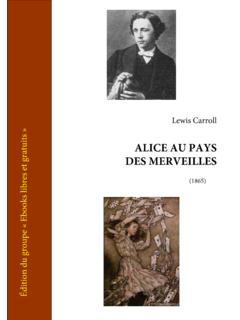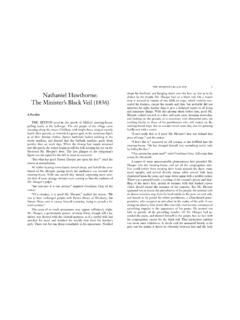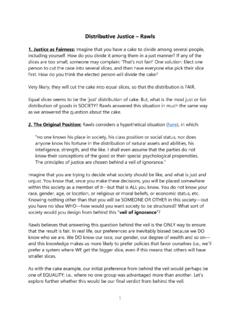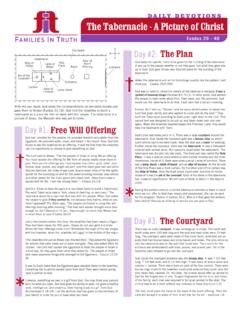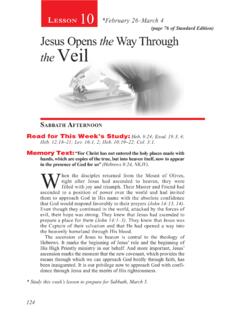Transcription of Company Law Lifting of Corporate Veil
1 Electronic copy available at: Law Lifting of Corporate Veil _____ _____ - 1 - IINNTTRROODDUUCCTTIIOONN When a Company is incorporated it is treated as a separate legal entity distinct from its promoters, directors, members, and employees; and hence the concept of the Corporate veil, separating those parties from the Corporate body, has arisen. The issue of " Lifting the Corporate veil" has been considered by courts and commentators for many years. However, the topic has not received the attention in the literature that one would No clear set of principles has emerged2 and it is difficult to predict when the courts will disregard the separate entity The need for English courts to resort to such metaphorical terms as "mere fraud," "sham," "dummy," "alter ego" in their judgments indicates their difficulties.
2 Nor do the English courts have a monopoly on metaphorical judgments. There is equal confusion and uncertainty in the Australian and United States Some researchers argue that the courts have become increasingly willing to lift the veil5 The central purpose of this paper is to investigate the bounds of the principle of limited liability. Part I of this paper will briefly survey the concept of Company as a separate entity. Part II deals with law of piercing the veil. Part III analyses the common law grounds of Lifting the veil that have been frequently proposed, to determine the underlying reasons for judicial disregard of the separate entity principle.
3 It is suggested in this paper that these common law exceptions, viz. agency, fraud, avoidance of obligations, prevention of injustice, and imputation of members' characteristics to the Company , are symptomatic of the courts' attempts to ensure that parties, both shareholders, creditors, and other third parties who may be considered by the court to have a legitimate interest in the affairs of the corporation, are not disadvantaged by actions of Company management and shareholders protected by limited liability. Part IV deals with the comparative aspect of the statutory provisions regarding piercing of veil.
4 Part V deals with the comparative analysis of UK, USA, German and Indian veil piercing jurisprudence. Part V reviews some of the more recent cases in which courts have applied their piercing tests. This flexibility extends, in the last resort, to "the view which the judge takes of the justice of the case before him." whilst others reach the opposite conclusion. 1 Gower, Principles of Modern Company Law, (4th ed., 1979), p. 112. 2 Pickering, "The Company as a Separate Legal Entity" (1968) 31 481, 483 3 Lipton and Herzberg, Understanding Company Law, (2nd ed., 1985), p.
5 22. 4 Swanson v. Levy 509 859 (1975), 862. ( Court of Appeals) 5 Schmitthoff, "Salomon in the Shadow", [1976] 305, 305-312; Electronic copy available at: Law Lifting of Corporate Veil _____ _____ - 2 - CCOOMMPPAANNYY:: AA SSEEPPAARRAATTEE LLEEGGAALL EENNTTIITTYY The Company as a separate entity was firmly established in the landmark decision in Salomon v. Salomon & Co. appeal, the House of Lords held that Salomon & Co. Ltd. was not a sham; that the debts of the corporation were not the debts of Mr. Salomon because they were two separate legal entities; and that once the artificial person has been created, "it must be treated like any other independent person with its rights and liabilities appropriate to itself.
6 " Salomon, a sole trader, sold his manufacturing business to Salomon & Co. Ltd. (a Company he incorporated) in consideration for all but six shares in the Company , and received debentures worth 10 thousand pounds. The other subscribers to the memorandum were his wife and five children who each took up one share. The business subsequently collapsed, and Salomon made a claim, on the basis of the debentures held, as a secured creditor. The liquidator argued that Salomon could not rank ahead of other creditors because, in fact, the Company and Mr. Salomon were one and the same--or alternatively, that the Company carried on business on Salomon's behalf.
7 As Lord Macnaghten observed:7 The Company is at law a different person altogether from the subscribers to the memorandum, and, though it may be that after incorporation the business is precisely the same as it was before, and the same persons are managers, and the same hands receive the profits, the Company is not in law the agent of the subscribers or trustee for them. Likewise, in Macaura v. Northern Assurance Co. the House of Lords decided that insurers were not liable under a contract of insurance on property that was insured by the plaintiff but owned by a Company in which the plaintiff held all the fully-paid shares.
8 The House of Lords held that only the Company as the separate legal owner of the property, and not the plaintiff, had the required insurable interest. The plaintiff, being a shareholder, did not have any legal or beneficial interest in that property merely because of his shareholding. Support for the doctrine has been exhibited more recently in Lee v. Lee's Air 6 Salomon v. Salomon & Co. Ltd. [1897] 22. The Privy Council held that Lee, as a separate and distinct entity from the Company which he 7 Ibid. at p. 51. 8 Macaura v. Northern Assurance Co. Ltd. [1925] 619.
9 9 Lee v. Lee's Air Farming [1961] 12. Company Law Lifting of Corporate Veil _____ _____ - 3 - controlled, could be an employee of that Company so that Lee's wife could claim workers' compensation following her husband's death. In Australia, there has been similar judicial support for the separate entity concept. Kitto J. in Hobart Bridge Co. Ltd. v. FCT,10 relying on the judgment by Lord Sumner in Gas Lighting Improvement Co. Ltd. v. IRC,11"Between the investor, who participates as a shareholder, and the undertaking carried on, the law imposes another person, real though artificial, the Company itself, and the business carried on is the business of that Company , and the capital employed is its capital and not in either case the business or the capital of the shareholders.
10 Assuming, of course, that the Company is duly formed and is not a sham .." summarises the position in the following manner: More recently, the High Court in Industrial Equity v. Blackburn12 EEXXCCEEPPTTIIOONNSS TTOO TTHHEE SSEEPPAARRAATTEE EENNTTIITTYY PPRRIINNCCIIPPLLEE has held that the principle operates to prevent a holding Company from treating a wholly-owned subsidiary's profits as its own. Therefore, it can be seen that there has been, and still is, the highest authority for the separate entity concept. In none of these cases, however, did the Court have to consider the limitations of the separate entity principle.
